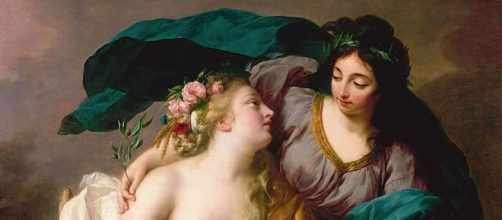Looking at old art in the light of nowadays is a check on whether a work transcends time. Tal Sterngast’s new book “Twelve Paintings” takes on the task with selections from a prized collection of European paintings – the Gemldegalleries in Germany.
Define creativity
Of particular interest at this time when the art world is trying to conquer its sexist ways is Sterngast’s chapter “The Creativity of Women.” It’s here that she focuses on Elisabeth Vigee Le Brun, the 18th-century French portrait painter. Why her? Why pick an artist known for painting no fewer than 20 portraits of the French queen Marie Antoinette, not to mention capturing more than 600 other likenesses?
Where exactly does “creativity of women” come into the picture?
Imitating Raphael
For example, where is the creativity in the composition of Le Brun’s popular portrait of herself with her daughter? It looks to be based on Raphael’s Madonna of the Chair. You see the same pyramidal arrangement used to depict the Holy Family during the Renaissance.
Subversive art
Artnet’s story about Sterngast’s book was headlined “A look at the subversive art of Elisabeth Vigee Le Brun.” What’s subversive about her portraits? Another puzzler: Sterngast picked the painter’s self-portrait, described by the owner Kimball Art Museum as a “lady of society – indistinguishable from her own patrons, including the queen.” All you get is Le Brun gift-wrapped in lush fabrics.
Better choice
It's odd that Sterngast didn’t choose the one image by Le Brun that isn’t a portrait. I’m thinking of her allegory called Peace Bringing Back Abundance - a history painting of two symbolic female characters interacting in a storytelling way.
But the story told in this painting may not be the intended story. What you see is Peace on the right tenderly embracing Prosperity, who, with one breast unaccountably exposed, looks up to Peace in a desirous way reminiscent of 19th-century painter Simeon Solomon’s image of the poet Erinna ardently reaching for the poet Sappho in Tate Britain’s collection. The only thing missing in Le Brun’s rendition is the pair of doves seated above Erinna and Sappho.
Gender bender
But wait, art scholar Mary D. Sheriff’s take on Le Brun’s allegorical picture - noted in her 1997 book “The Exceptional Woman: Elisabeth Vigee Lebrun and the Cultural Politics of Art” - changes genders. What you see, she says, is actually a relationship between male and female.
In her book, Mary Sheriff explained that because Pace's role is traditionally male and Abundance is female, the painting represents the difference between “power and dependency, with Peace guiding and controlling the pliant, sensual and dependent figure of Abundance.”
Making connections
LeBrun’s bios say that Peace Bringing Back Abundance got her into the French Royal Academy – a rarity for women back then.
You have to wonder if that lone exposed breast moved the all-male jury in Le Brun’s favor. Either that or her connection to Marie Antoinette helped.
In any case, Sterngast should have focused on this allegorical painting instead of the “lady of society” self-portrait. There’s more there. Art Daily quotes Sterngast’s goal for her book: she looked at Old Master pictures “as if they were contemporary art…in order to return to the present better equipped.” Feeling better equipped, anybody?
.


